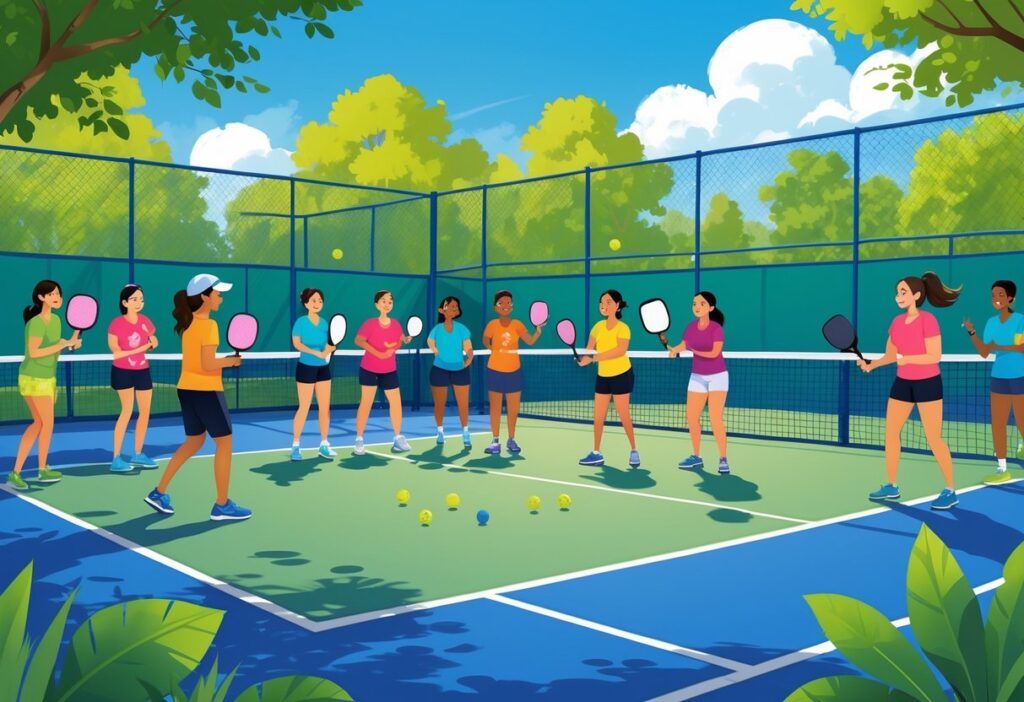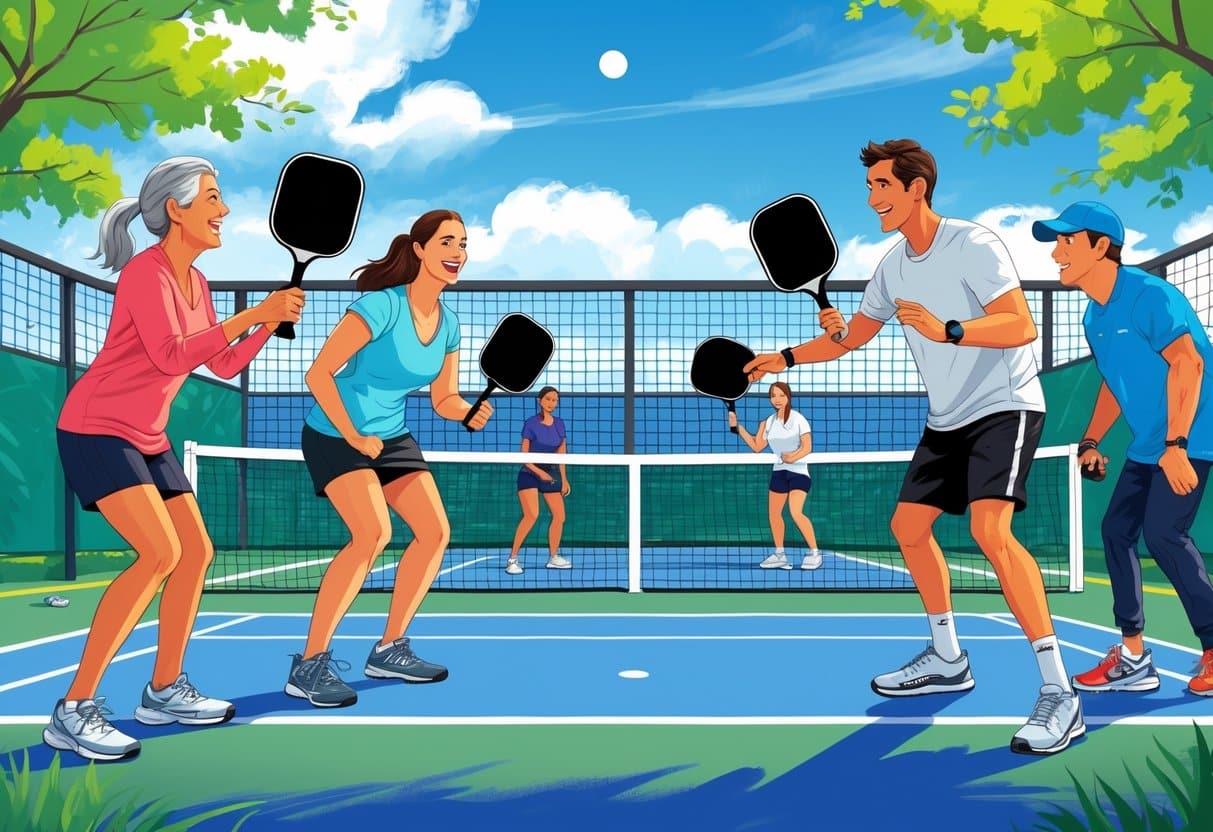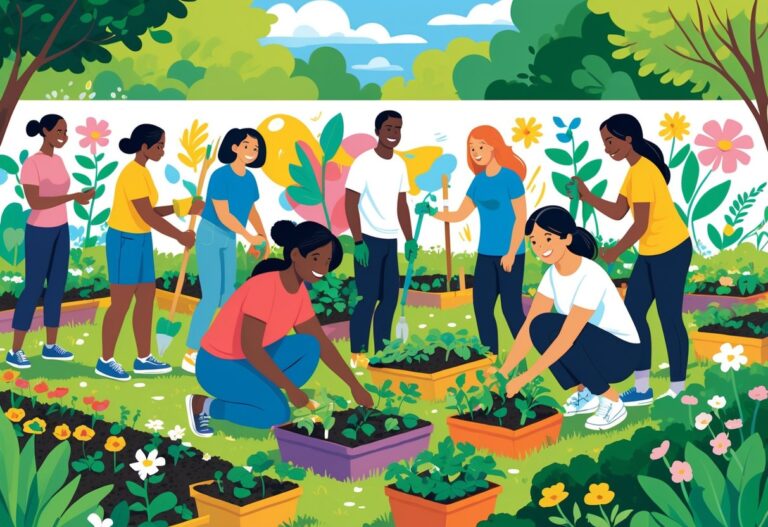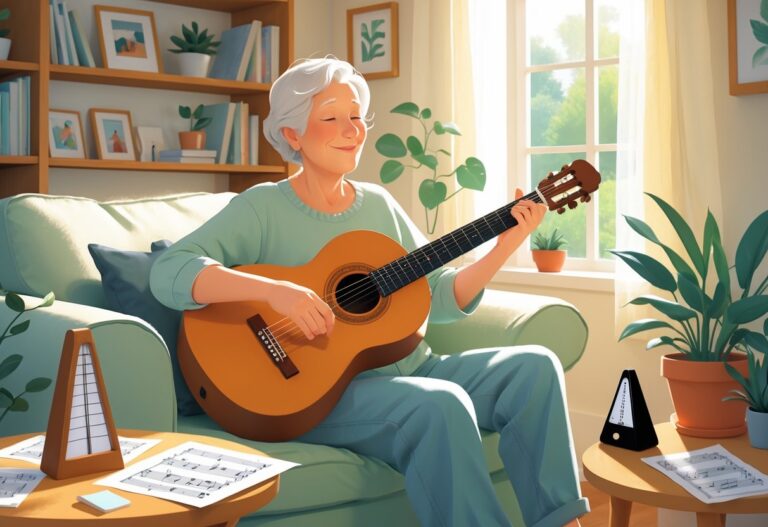Pickleball blends tennis, badminton, and ping-pong into a sport that’s surprisingly easy to pick up. You can start playing almost right away after grabbing a paddle, which is part of why so many people try it.
Want to try pickleball for the first time? You’ll just need to get familiar with the gear, find a place to play, and learn a handful of rules.
Most rec centers and parks have courts now, and you can usually borrow equipment when you’re new.
Your first time out, you’ll figure out how to grip the paddle and get used to the serve. The smaller court size might feel odd at first, but it’s easier on your body.
Pickleball welcomes everyone, no matter your age or skill. The community tends to be encouraging, so you won’t feel out of place.
If you focus on the basics, you’ll probably have a blast your first game. Technique and fundamentals come with practice.
Understanding Pickleball Basics
Pickleball takes bits from tennis, badminton, and ping-pong, but it’s got its own twist. The gear is unique, and the rules are straightforward enough that anyone can jump in.
What Is Pickleball?
You play pickleball on a court that’s the size of a badminton court, with a net like tennis but a little lower. The paddles are solid—wood, composite, or graphite—and you use a plastic ball with holes, kind of like a wiffle ball.
The court is 20 feet wide and 44 feet long. That’s about a third of a tennis court, so you don’t have to run as much.
You can play singles or doubles, but doubles is the usual choice. In doubles, two people are on each side.
Games usually go to 11 points, and you have to win by two. The ball doesn’t fly as fast as a tennis ball, so rallies can last longer.
Brief History and Growth
Pickleball started back in 1965 on Bainbridge Island, Washington. Some families invented it to keep their kids busy during summer.
They used ping-pong paddles and a plastic ball on a badminton court. It was kind of a backyard experiment at first.
For a while, not that many people played. But in the past few years, pickleball’s popularity has exploded.
From 2019 to 2023, the number of players jumped by over 200%. Now, more than 4.8 million Americans play pickleball regularly.
The USA Pickleball Association (USAPA) started up in 1984. They make the official rules and oversee tournaments.
You can find courts in parks and rec centers almost everywhere. A lot of tennis courts have pickleball lines now.
Key Terms Beginners Should Know
The Kitchen – This is the 7-foot zone on both sides of the net. You can’t hit the ball in the air here.
Volley – When you hit the ball before it bounces.
Dink – A soft shot that lands in the opponent’s kitchen, usually close to the net.
Double Bounce Rule – The ball has to bounce once on each side before you can volley.
Fault – Any mistake that ends the rally, like hitting out or into the net.
Serve – You have to serve underhand, below your waist, and it needs to land in the diagonal service box.
Knowing these basic terms and rules makes it way easier to follow along and talk with other players.
Essential Equipment for First-Time Players

You don’t need much to start playing pickleball. A paddle, decent shoes, and a ball are really all it takes.
Choosing a Pickleball Paddle
The paddle you pick makes a difference in how you play and how comfortable you feel. For beginners, focus on weight, grip size, and what the paddle’s made of.
Weight is a big deal for control. Lighter paddles (under 7.5 oz) are easier to swing and won’t tire your arm out as quickly. Heavier paddles give you more power but take a bit more strength.
Grip size matters for comfort and avoiding injury. Measure from your palm crease to the tip of your ring finger. Most people need a grip between 4 and 4⅝ inches around.
Material affects price and feel:
- Wood paddles: $15-30. They’re heavier but last a long time, good for casual games.
- Composite paddles: $40-80. These are a nice balance of power and control.
- Graphite paddles: $80-150. Super light and responsive, but pricier.
If you’re not sure, try a composite paddle around 7.5-8 ounces. It’s forgiving while you figure out your swing. Beginner gear guides usually recommend something in this range.
Selecting Appropriate Court Shoes
Shoes are more important than people think. The right pair keeps your ankles happy and helps you move better.
Court shoes are built for side-to-side moves. Pickleball isn’t just running forward—there’s a lot of shuffling and quick steps.
Non-marking soles are usually required. You don’t want to leave black streaks on the court.
Look for:
- Low profile for good court feel
- Reinforced toes (they get scuffed)
- Cushioning for comfort
- Breathable uppers
Tennis shoes work fine for pickleball, since the movement is similar. Avoid running shoes—they’re for straight lines, not side shuffles, and can trip you up.
Pickleball Balls and Accessories
Pickleball balls come in indoor and outdoor versions, and they’re not quite the same.
Outdoor balls are harder and have 40 small holes. They handle wind better but play faster.
Indoor balls are softer and have 26 bigger holes. They’re easier to control and move slower.
A few handy extras:
- Sunglasses: For sunny days
- Hat or visor: Keeps sun out of your eyes
- Water bottle: You’ll need it
- Towel: Sweaty hands mess up your grip
Most places have balls to borrow, but bringing your own means you know what to expect. Equipment guides suggest getting balls approved by USA Pickleball.
If your hands sweat a lot, try a grip glove or wristbands.
Finding a Place to Play Pickleball

Finding a court is easier than ever. Online searches, community centers, and beginner sessions are all good places to start.
Locating Local Courts
Just type “pickleball courts near me” into Google. You’ll get a list with addresses and phone numbers right away.
Community centers are a great bet, especially for beginners. Many have indoor courts and rent out paddles.
Public parks often turn tennis courts into pickleball courts. These are usually free.
Senior centers might sound exclusive, but they’re open to all ages. They often have a slower pace, which is nice when you’re learning.
Common places to check:
- Rec centers
- Parks
- Senior centers
- YMCA
- Private clubs
- Tennis courts with pickleball lines
It’s worth calling ahead. Some places need reservations or only allow open play at certain times.
Joining Beginner Pickleball Sessions
Look for clinics or “learn to play” classes at your local courts. These are designed for newbies and usually include everything you need.
Instructors walk you through the basics and provide paddles and balls. You can try it out before spending money on gear.
If you’re feeling brave, show up to an open play session. Let folks know you’re new; most players are friendly and willing to help.
Why try beginner sessions?
- You get real instruction
- Equipment is often included
- You’ll meet other beginners
- It’s safer and less intimidating
Ask about beginner hours when you call or check the schedule. Some places separate new players from experienced ones.
Using the USAPA Finder Tool
The USA Pickleball Association has Places2Play, a big directory of courts. It lists locations, contacts, and play times.
Just enter your zip code or city to see what’s nearby. You can check if courts are indoor or outdoor, public or private, and if they offer lessons.
Pickleheads is another handy site. It lists over 22,000 places to play and helps you find local players.
These tools show:
- Where courts are and how to contact them
- If they’re public or private
- Indoor or outdoor
- Lesson availability
- Open play times
Both work on your phone or computer. Save your favorites for next time—schedules can change, so check back often.
Preparing for Your First Game
A little prep goes a long way. Warming up, dressing right, and drinking water help you feel ready and avoid injuries.
Warming Up and Stretching
Your body needs a heads-up before you start playing. Do some light movement, like walking around the court or swinging your arms for a few minutes.
Focus on shoulders, wrists, and ankles—they get the most action in pickleball. Try rolling your shoulders back and forth ten times each.
Good stretches:
- Shoulder rolls and arm swings
- Wrist circles both ways
- Calf raises and ankle rolls
- Side bends for your core
Hold each stretch for 15-20 seconds. You want to feel loose, not strained.
Pay extra attention to your paddle arm and wrist. They do a lot of work, and you want to avoid soreness.
Selecting Comfortable Attire
Wear clothes that move with you. Cotton or moisture-wicking fabrics keep you comfortable.
Go for shorts or pants that don’t ride up. Your shirt should let you swing your arms without feeling tight.
For shoes:
- Court shoes with good grip
- Low profile for stability
- Decent arch support
- Snug fit, but not too tight
Skip running shoes—they’re not made for side-to-side movement. Tennis or cross-trainers are much better.
If you’re playing outside, a hat or visor helps with the sun. It can be tough to track the ball otherwise.
Staying Safe and Hydrated
Drink water before, during, and after you play. Even if you don’t feel sweaty, you’re losing fluid.
Bring a water bottle—16 to 20 ounces is good. Take sips between games instead of waiting until you’re thirsty.
Safety tips:
- Take off jewelry that might snag
- Tie up long hair
- Use sunscreen outdoors
- Know where the first aid kit is
Pay attention to your body. If you feel dizzy, tired, or something hurts, take a break.
Start with short games. Your stamina will build as you play more.
Learning the Rules and Court Layout
The pickleball court is divided into zones that control how you play certain shots. The rules for scoring and bouncing are different from tennis.
The non-volley zone (the kitchen) stops players from smashing right at the net. The double-bounce rule keeps rallies fair and gives everyone a chance to react.
Understanding the Non-Volley Zone
The non-volley zone, or “kitchen,” is a 7-foot area on each side of the net. You can’t hit volleys while any part of your body is in this zone.
Key Kitchen Rules:
- Don’t hit the ball out of the air while standing in or on the line.
- Don’t let your momentum carry you into the zone after a volley.
- You can step in to play balls that bounce first.
- The line itself counts as part of the kitchen.
If you hit a volley and then step into the kitchen, that’s a fault. Your team loses the point, even if your shot was good.
Basic Game Rules and Scoring
Pickleball uses a three-number scoring system, announced before each serve as something like “0-0-2.” The first number is your team’s score, the second is the opponent’s score, and the third shows which player is serving.
Scoring Basics:
- Games go to 11 points.
- You must win by 2 points.
- Only the serving team can score.
- You keep serving until your team loses a rally.
You serve until you lose a point, then your partner serves. When both players lose their serve, the other team gets to serve.
At the start of the game, the first team only gets one serve instead of two. That’s why the first call is “0-0-2.”
The Double-Bounce Rule
The ball has to bounce once on each side before anyone can hit volleys. This rule applies to every rally and stops the serving team from rushing the net right away.
How It Works:
- The serve must bounce on the receiving side.
- The return must bounce on the serving side.
- After those two bounces, you can volley.
Once both bounces happen, normal play continues. You can hit volleys anywhere except in the non-volley zone.
Step-by-Step Guide to Playing Your First Pickleball Game
Start by learning the underhand serve from the right service court. Stay behind the baseline until the ball bounces, then move up toward the net and try out gentle dink shots.
Serving and Returning the Ball
You serve underhand in pickleball, with your paddle below your waist. Stand behind the baseline on the right side of your service court.
Aim your serve diagonally across the net into the opposite service box. The ball has to bounce once in the correct area for the serve to count.
Key Serving Rules:
- Keep both feet behind the baseline.
- Hit the ball below your waist level.
- Make contact with the paddle below your wrist.
- Serve cross-court to the diagonal box.
When you return a serve, let the ball bounce first. This is the two-bounce rule in pickleball rules for beginners.
Stay near the baseline to return serves. Hit the ball back over the net after it bounces once on your side.
After both the serve and return bounce, you can hit the ball in the air or after it bounces. This gives you more ways to play the point.
Positioning and Movement Basics
Start each point behind the baseline when you serve or return. Move up toward the net after the two required bounces.
The non-volley zone is seven feet from the net on both sides. You can’t hit the ball in the air while standing in this area.
Try to get to the non-volley line during rallies. This spot gives you better court coverage and more shot options.
Basic Court Positions:
- Baseline: For serving and returning.
- Mid-court: Just a transition area.
- Non-volley line: Main playing position.
- Kitchen: No volleys allowed.
Move side to side during rallies instead of just forward and backward. Keep your knees bent and stay on your toes.
Watch your partner’s position in doubles. Move as a team and cover the court together.
Trying Out Dinks and Volleys
Dinks are soft shots that land in the non-volley zone near the net. Use gentle wrist action to drop the ball just over.
Stand at the non-volley line and dink with an upward paddle motion. Keeping the ball low makes it harder for your opponents.
Try dinking cross-court first—it gives you more net clearance. Aim for your opponent’s feet or toward the sidelines.
Dinking Tips:
- Use a light grip.
- Keep the paddle face open.
- Follow through upward.
- Stay patient during dink exchanges.
Volleys are shots you hit in the air before the ball bounces. Only volley when you’re behind the non-volley line.
Use a short, compact swing for volleys. Keep your paddle out in front and react quickly to incoming shots.
Focus on placement, not just power, for both dinks and volleys. Essential pickleball tips for beginners say control matters more than aggression when you’re starting out.
Beginner Tips for a Fun First Pickleball Experience
Your first pickleball game really sets the tone for your journey in the sport. Focus on etiquette, set small goals, and think about how you’ll keep improving after that first match.
Playing with Others and Etiquette
Pickleball has a strong community vibe that makes it fun for everyone. Introduce yourself to other players before you start a game.
Wait your turn patiently when others are playing. Most courts use a rotation system where winners stay and new players rotate in.
Call your own faults honestly—foot faults on serves, balls that land out, all of it. People respect honesty.
Keep the noise reasonable. Pickleball can get loud, but don’t overdo the celebrating or complaining.
Retrieve balls quickly if they roll onto your court from other games. Toss them back gently between points, not while play is happening.
Talk with your doubles partner. Calling “mine” or “yours” helps avoid confusion and missed shots.
Basic pickleball etiquette helps everyone feel welcome.
Setting Realistic Goals
Your first pickleball experience should be about simple wins, not just winning games. Try to keep the ball in play for three hits in a row.
Practice your serve by landing five in the correct service box. Don’t stress about power or perfect placement.
Focus on hitting the ball after one bounce instead of going for tricky volleys. This builds confidence and rhythm.
Set a goal to learn one new rule during your first session. Maybe it’s understanding the non-volley zone or how serving rotation works.
Try for rallies that last 10-15 shots. Longer exchanges help you get a feel for timing and positioning.
Learning pickleball basics takes time. Celebrate your small wins and enjoy those first games.
Progressing Beyond Your First Game
Schedule your second pickleball session within a week. It’s easier to remember the basics when you don’t wait too long.
Consistency beats intensity for beginner pickleball players. You don’t have to go all-out every time; just show up regularly.
Think about joining a beginner clinic or group lesson. Lots of places offer structured learning, and honestly, it works better than just jumping into games.
Practice basic shots at home. If you’ve got a garage wall or a backyard fence, that’s perfect. Try your forehand and backhand swings—even without a ball, it helps.
Take a few minutes during breaks to watch other players. You can pick up a lot just by seeing how experienced folks move and place their shots.
Check out beginner-friendly groups or leagues nearby. Tons of communities have programs that match you up by skill level, which makes things way less intimidating.
Keep a simple practice log. Jot down one thing that went well and one thing you want to work on next time. Doesn’t need to be fancy.
If you want more ideas or just need a little guidance, Pickleball tips for beginners might help you figure out your next steps.





